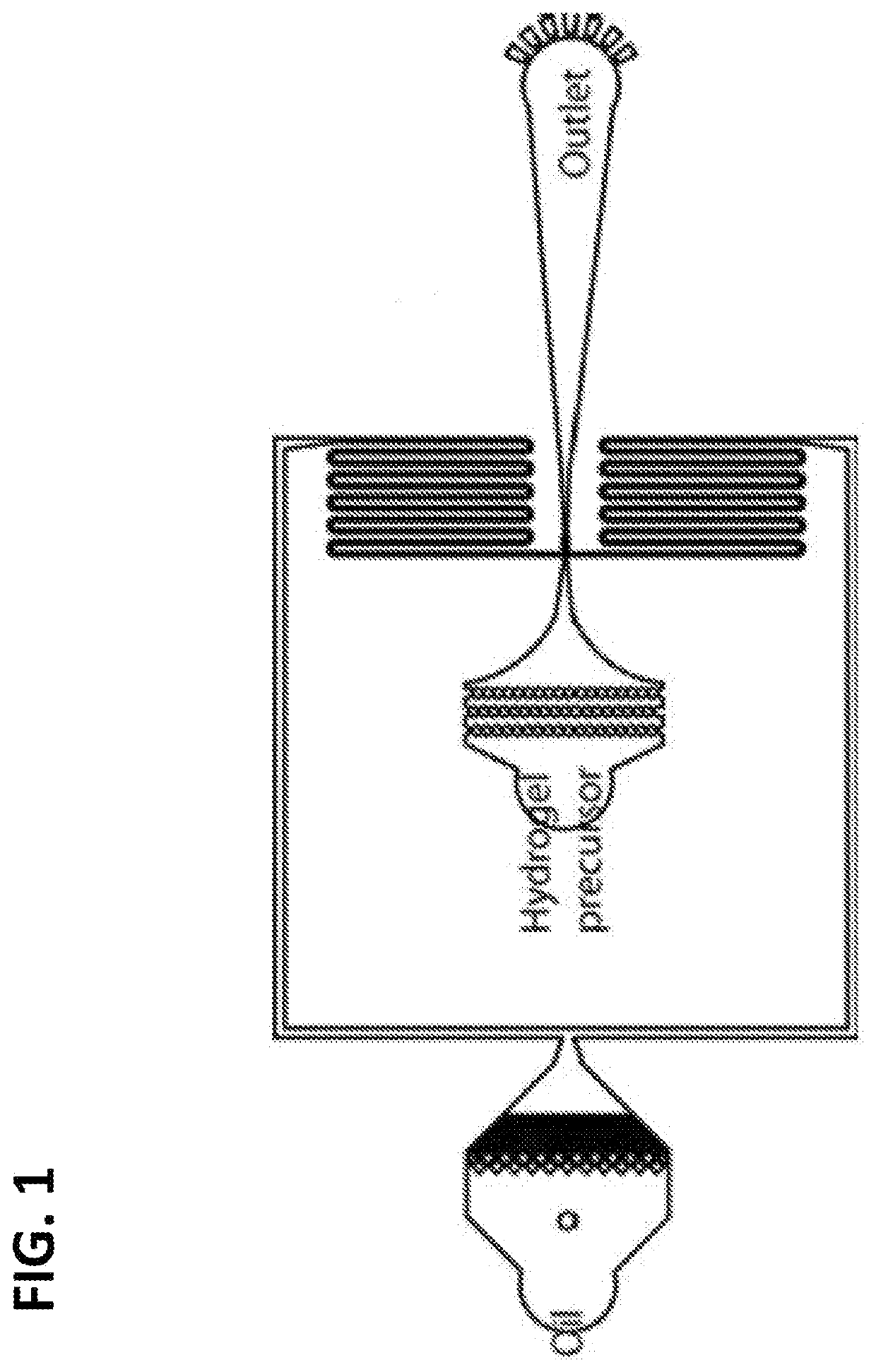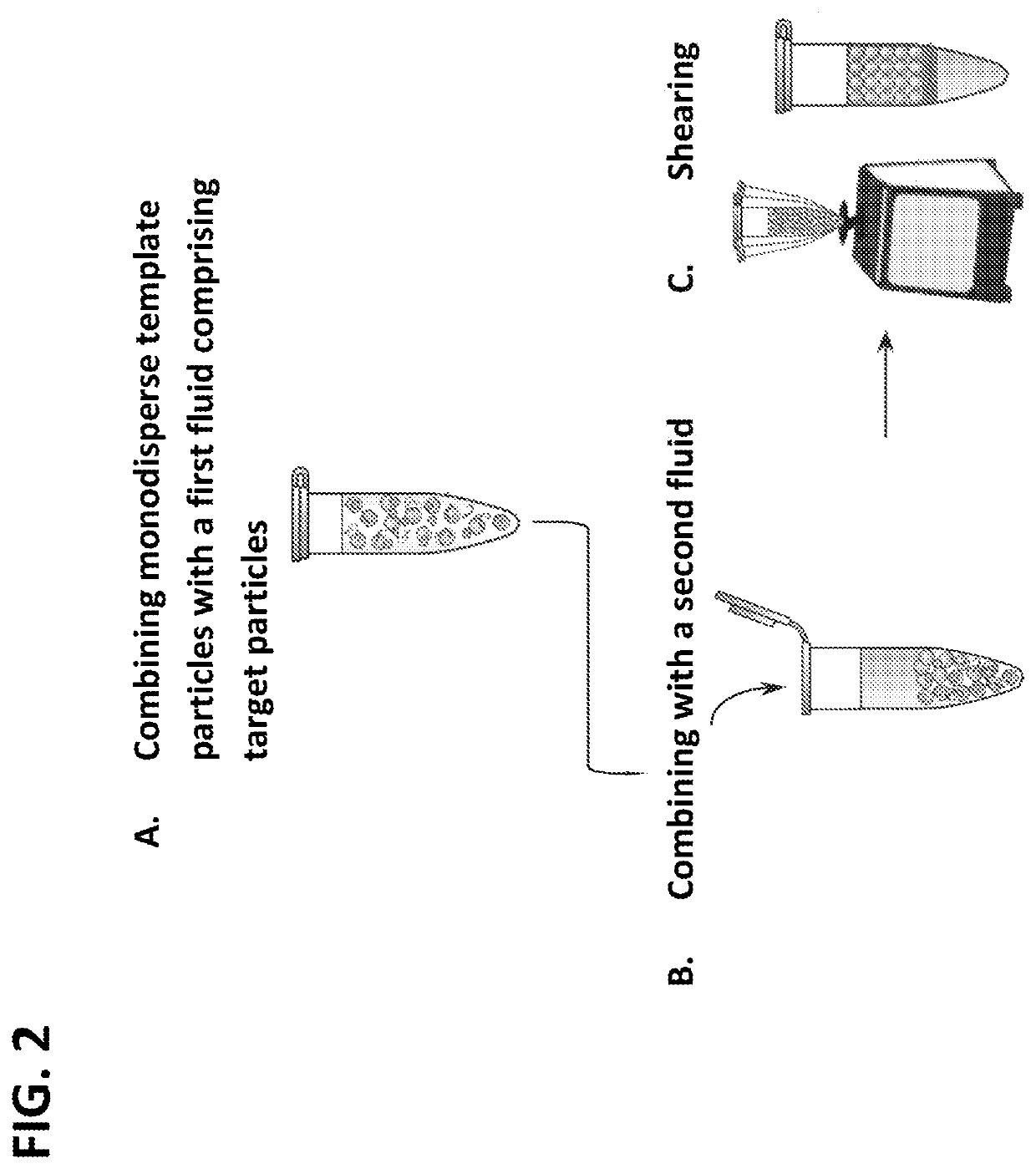Method of generating monodisperse emulsions
a monodisperse and emulsion technology, applied in the field of generating monodisperse emulsions, can solve the problems of preventing the implementation of new, useful droplet techniques, and affecting the use of droplet microfluidics by researchers, and preventing the effect of affecting the use of droplet microfluidics
- Summary
- Abstract
- Description
- Claims
- Application Information
AI Technical Summary
Benefits of technology
Problems solved by technology
Method used
Image
Examples
example 1
g Monodisperse Single Emulsions Using Particle-Templated Emulsification (PTE)
Results
[0334]Hydrogel particles that were greater than 95% aqueous were used for the templating, so that the final droplet was mostly aqueous, as needed for performing biochemical reactions in the resultant droplets. The particles were added to the solution to be encapsulated, with oil and surfactant, and the mixture vortexed (FIG. 2, Panels A-C and FIG. 3, Panels A-E). The hydrogel particles were permeable to molecules with hydraulic diameters smaller than the pore size, like small molecules, but were impermeable to large molecules, such as genomic DNA, which remained within the thin layer of aqueous solution surrounding the particles in the droplets. During vortexing, the particles were dispersed into continually smaller droplets until each droplet contained just one particle and a thin shell of aqueous solution, as illustrated in (FIG. 3, Panel E). Beyond this, further droplet breakup was suppressed beca...
example 2
g Particle Templated Emulsification
Results
[0336]While emulsions prepared by vortexing in the absence template particles were easily prepared, such emulsions were polydisperse and of limited value for precision biology (FIG. 4, Panel A). As shown in FIG. 4, Panel A (left), vortexed emulsions with no particles generated polydisperse droplets having varied size distribution, 8-218 μm in diameter (n=561) and 4.3% of droplets are 35-40 μm. On the other hand, microfluidic emulsions required specialized devices and skill, but exhibited superior monodispersity and were highly valuable (FIG. 4, Panel A). As shown in FIG. 4, Panel A (right), microfluidics emulsion generated monodisperse droplets: 95.7% of droplets are 35-38 μm in diameter (n=816). An improved method for sample encapsulation would, thus, combine the simplicity of vortexing with the quality of microfluidics.
[0337]PTE accomplished this by exploiting the rigidity of particles to resist droplet breakup below the particle size, eve...
example 3
ed Accurate DNA Quantification with Digital Droplet PCR (ddPCR)
Results
[0346]PTE allowed facile, microfluidics-free ddPCR. To illustrate this, PTE was used to encapsulate several DNA samples at different concentrations of a target molecule (FIG. 8, Panel A). Just as in microfluidic ddPCR, increasing target concentration increased the number of fluorescent droplets. To determine whether this allowed concentration estimation, conventional ddPCR analysis was followed and droplet fluorescence quantified using imaging, plotting the results as fluorescence versus diameter (FIG. 8, Panel B). Three droplet populations were visible, at low fluorescence and small diameter (satellite droplets), at the expected 30-40 μm diameter and low fluorescence (PCR-negative), and a similar size range but high fluorescence (PCR-positive). The satellite droplets were ignored and the target concentration for the correctly-sized droplets modelled via Poisson statistics,
[0347]λ=−ln(1−p), where λ is the template...
PUM
| Property | Measurement | Unit |
|---|---|---|
| diameter | aaaaa | aaaaa |
| diameter | aaaaa | aaaaa |
| diameter | aaaaa | aaaaa |
Abstract
Description
Claims
Application Information
 Login to View More
Login to View More - R&D
- Intellectual Property
- Life Sciences
- Materials
- Tech Scout
- Unparalleled Data Quality
- Higher Quality Content
- 60% Fewer Hallucinations
Browse by: Latest US Patents, China's latest patents, Technical Efficacy Thesaurus, Application Domain, Technology Topic, Popular Technical Reports.
© 2025 PatSnap. All rights reserved.Legal|Privacy policy|Modern Slavery Act Transparency Statement|Sitemap|About US| Contact US: help@patsnap.com



